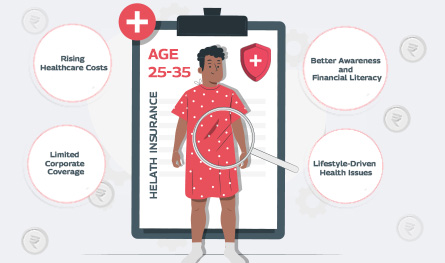Income Tax Slabs: Income Tax Slabs Old Regime for Individual, Senior Citizens and Super Seniors FY 2024-25
.png)
Delving deeper into the old and new tax regimes for the Indian taxpayer, the income tax slabs under both the regimes, and the rates for the FY 2024-25.
.png)
We pay taxes to avail the essential amenities that our country provides for our benefit. The tax money collected by the Indian government is put to use to serve us better. In India, the general norm is that the Union Finance Minister declares the income tax slabs under which the Indian tax-paying individuals would be required to pay taxes for that particular financial year. These slabs are announced as part of the Union Budget presented in Feb-March every year. There are two types of income tax regimes currently followed in the country – the old tax regime and the new tax regime.
Here we discuss in detail both the old tax regime slabs and the new ones to help you better understand which ones you fall under while completing your tax-paying duties.
Meaning of Income Tax Slab – What is an Income Tax Slab?
Before we move on to discussing the two different types of tax regimes and their key differences, let us briefly understand what an income tax slab is.
As is evident from the term, income tax slab refers to a particular slab or bar under which every tax-paying individual in the country falls based on their annual income. This means that those who have a higher annual income would fall under a different tax slab than others earning relatively lesser, and the former would also need to pay higher taxes.
The whole idea of introducing different income tax slabs in India was to maintain fairness across the country and its tax-paying citizens. People should ideally need to pay exactly the amount of tax as the income that they earn in a year. Also, these tax slabs keep changing every financial year when the Finance Minister introduces the budget.
Income Tax Slabs Old Regime
As mentioned above, with new income tax slabs being announced every year, there are currently two different types of slab systems in the country – the old income tax slabs and the new tax regime slabs. The old tax regime refers to the income tax slabs announced for the financial year 2024-25 while the new tax regime also includes tax slabs declared for the AY 2024-25 along with the revised income tax slabs for FY 2023-24.
Here we list out the income tax slabs for three different categories of tax-payers – those aged below 60 years, those between 60 and 80 years of age, and those aged above 80 years.
Income Tax Slabs Old Regime for <60 Years
| Income Tax Slab | Rate of Income Tax Payable |
| Up to Rs. 2,50,000 | N/A |
| Between Rs. 2,50,000 and Rs. 5,00,000 | 5% of the annual income, if it is over Rs. 2,50,000 + 4% cess (surcharge) |
| Between Rs. 5,00,000 and Rs. 10,00,000 | 20% of the annual income, if it is over Rs. 5,00,000 + Rs. 12,500 + 4% cess |
| Over Rs. 10,00,000 | 30% of the annual income, if it is over Rs. 10,00,000 + Rs. 1,12,500 + 4% cess |
Old Tax Slabs in India for Senior Citizens Aged Between 60 and 80 Years
| Income Tax Slab | Rate of Income Tax Payable |
| Up to Rs. 3,00,000 | N/A |
| Between Rs. 3,00,000 and Rs. 5,00,000 | 5% of the annual income, if it is over Rs. 3,00,000 + 4% surcharge |
| Between Rs. 5,00,000 and Rs. 10,00,000 | 20% of the annual income, if it is over Rs. 5,00,000 + Rs. 12,500 + 4% surcharge |
| Over Rs. 10,00,000 | 30% of the annual income, if it is over Rs. 10,00,000 + Rs. 1,10,000 + 4% surcharge |
Income Tax Slab for Super Senior Citizens Over 80 Years Old
| Income Tax Slab | Rate of Income Tax Payable |
| Up to Rs. 3,00,000 | N/A |
| Between Rs. 5,00,000 and Rs. 10,00,000 | 20% of the annual income, if it is over Rs. 5,00,000 + 4% surcharge |
| Over Rs. 10,00,000 | 20% of the annual income, if it is over Rs. 10,00,000 + Rs. 1,00,000 + 4% surcharge |
Income Tax Slabs New Regime
After looking at the income tax slabs for the existing old regime in the sections above, let us now look at the slabs announced in the new regime, i.e., for FY 2023-24 (AY 2024-25).
| Income Tax Slab | Rate of Tax Payable |
| Up to Rs. 2,50,000 | N/A |
| Between Rs. 2,50,000 and Rs. 5,00,000 | 5% of the annual income which is >Rs. 2,50,000 |
| Between Rs. 5,00,000 and Rs. 7,50,000 | 10% of the annual income which is >Rs. 5,00,000 + Rs. 12,500 |
| Between Rs. 7,50,000 and Rs. 10,00,000 | 15% of the annual income which is >Rs. 7,50,000 + Rs. 37,500 |
| Between Rs. 10,00,000 and Rs. 12,50,000 | 20% of the annual income which is >Rs. 10,00,000 + Rs. 75,000 |
| Between Rs. 12,50,000 and Rs. 15,00,000 | 25% of the annual income which is >Rs. 12,50,000 + Rs. 1,25,000 |
| More than Rs. 15,00,000 | 30% of the annual income which is >Rs. 15,00,000 + Rs. 1,87,500 |
Note: The new income tax slabs are optional, meaning the tax-payer can choose to continue paying taxes as per the old regime or opt for the new regime.

Author Bio
Paybima Team
Paybima is an Indian insurance aggregator on a mission to make insurance simple for people. Paybima is the Digital arm of the already established and trusted Mahindra Insurance Brokers Ltd., a reputed name in the insurance broking industry with 17 years of experience. Paybima promises you the easy-to-access online platform to buy insurance policies, and also extend their unrelented assistance with all your policy related queries and services.
Other Life Insurance Products
Latest Post

Relocating your two-wheeler to a different state needs to follow many procedures. Depending on the duration for which you are moving to the new place, it becomes necessary to transfer your vehicle papers if it is for more than a year. Although tedious, the process of relocating vehicles can become easy if you follow certain tips mentioned in this post. Read on!


In what’s being called a quiet healthcare revolution, India’s young working professionals are reportedly making the most health insurance claims – outpacing even senior citizens. Surprised? So are the insurance providers. Young adults ranging between 25 and 35 years, who are often assumed to be in peak health, are now dominating the charts in health insurance claims by age.


If you think lifestyle-related health issues only show up after 40, think again. Youth no longer guarantees immunity. Today’s 25 - 35 age group is increasingly facing medical issues that only plague older adults. The reason? Long working hours at the desk, deliveries on speed dial, and a social life that rarely includes a decent amount of sleep are some of the reasons for the early onset of medical conditions like diabetes, anxiety, and hypertension.


Remember when a simple doctor’s visit felt like planning a mini-event? First, you had to book an appointment days ahead, then sit in a crowded waiting room, scrolling aimlessly while watching the clock tick past your slot. It's not exactly the highlight of anyone’s week. Well, those days are pretty much over. Enter telemedicine – the futuristic healthcare option that is slowly becoming the cornerstone of modern medical insurance plans. From coughs to consultations, you can now connect with a doctor from your living room or your office—or even mid-binge on your favourite series. It’s healthcare that works around your schedule, not the other way around.


.png)
